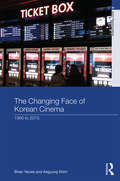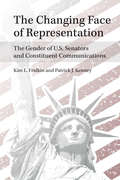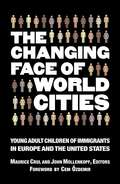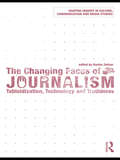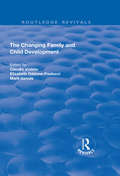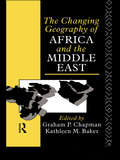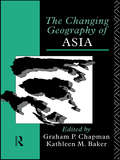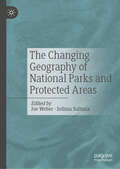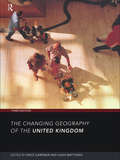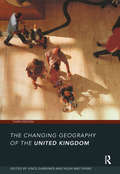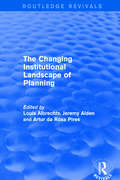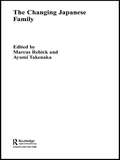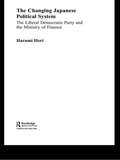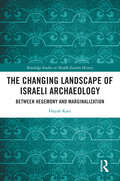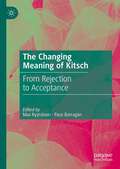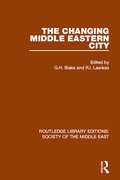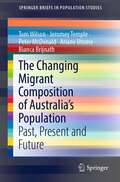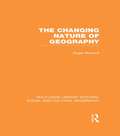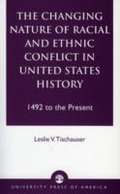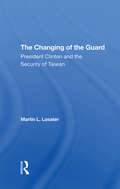- Table View
- List View
The Changing Face of Japanese Retail: Working in a Chain Store (Nissan Institute/Routledge Japanese Studies)
by Louella MatsunagaThis book examines employment structure, working practice and recruitment strategies in Japanese retail in the 1990s through a case-study of one large chain store. Issues focused on include gender in the workplace, changing notions of corporate community and the impact of Japan's recent recession. In particular the research presented here challenges the view of part-time female staff as peripheral to the workforce and asks whether a rethink of the Japanese employment system is now overdue.
The Changing Face of Korean Cinema: 1960 to 2015 (Asia's Transformations)
by Brian Yecies Aegyung ShimThe rapid development of Korean cinema during the decades of the 1960s and 2000s reveals a dynamic cinematic history which runs parallel to the nation’s political, social, economic and cultural transformation during these formative periods. This book examines the ways in which South Korean cinema has undergone a transformation from an antiquated local industry in the 1960s into a thriving international cinema in the 21st century. It investigates the circumstances that allowed these two eras to emerge as creative watersheds, and demonstrates the forces behind Korea’s positioning of itself as an important contributor to regional and global culture, and especially its interplay with Japan, Greater China, and the United States. Beginning with an explanation of the understudied operations of the film industry during its 1960s take-off, it then offers insight into the challenges that producers, directors, and policy makers faced in the 1970s and 1980s during the most volatile part of Park Chung-hee’s authoritarian rule and the subsequent Chun Doo-hwan military government. It moves on to explore the film industry’s professionalization in the 1990s and subsequent international expansion in the 2000s. In doing so, it explores the nexus and tensions between film policy, producing, directing, genre, and the internationalization of Korean cinema over half a century. By highlighting the recent transnational turn in national cinemas, this book underscores the impact of developments pioneered by Korean cinema on the transformation of ‘Planet Hallyuwood’. It will be of particular interest to students and scholars of Korean Studies and Film Studies.
The Changing Face of Representation: The Gender of U.S. Senators and Constituent Communications
by Kim Fridkin Patrick KenneyAs the number of women in the U.S. Senate grows, so does the number of citizens represented by women senators. At the same time, gender remains a key factor in senators' communications to constituents as well as in news media portrayals of senators. Focusing on 32 male and female senators during the 2006 congressional election year, Kim L. Fridkin and Patrick J. Kenney examine in detail senators' official websites, several thousand press releases and local news stories, and surveys of 18,000 citizens to discern constituents' attitudes about their senators. The authors conclude that gender role expectations and stereotypes do indeed constrain representational and campaign messages and influence news coverage of both candidates and elected senators. Further, while citizens appear to be less influenced by entrenched stereotypes, they pay more attention to female senators' messages and become more knowledgeable about them, in comparison to male senators.
The Changing Face of World Cities: Young Adult Children of Immigrants in Europe and the United States
by John Mollenkopf Maurice CrulA seismic population shift is taking place as many formerly racially homogeneous cities in the West attract a diverse influx of newcomers seeking economic and social advancement. In The Changing Face of World Cities, a distinguished group of immigration experts presents the first systematic, data-based comparison of the lives of young adult children of immigrants growing up in seventeen big cities of Western Europe and the United States. Drawing on a comprehensive set of surveys, this important book brings together new evidence about the international immigrant experience and provides far-reaching lessons for devising more effective public policies. The Changing Face of World Cities pairs European and American researchers to explore how youths of immigrant origin negotiate educational systems, labor markets, gender, neighborhoods, citizenship, and identity on both sides of the Atlantic. Maurice Crul and his co-authors compare the educational trajectories of second-generation Mexicans in Los Angeles with second-generation Turks in Western European cities. In the United States, uneven school quality in disadvantaged immigrant neighborhoods and the high cost of college are the main barriers to educational advancement, while in some European countries, rigid early selection sorts many students off the college track and into dead-end jobs. Liza Reisel, Laurence Lessard-Phillips, and Phil Kasinitz find that while more young members of the second generation are employed in the United States than in Europe, they are also likely to hold low-paying jobs that barely life them out of poverty. In Europe, where immigrant youth suffer from higher unemployment, the embattled European welfare system still yields them a higher standard of living than many of their American counterparts. Turning to issues of identity and belonging, Jens Schneider, Leo Chávez, Louis DeSipio, and Mary Waters find that it is far easier for the children of Dominican or Mexican immigrants to identify as American, in part because the United States takes hyphenated identities for granted. In Europe, religious bias against Islam makes it hard for young people of Turkish origin to identify strongly as German, French, or Swedish. Editors Maurice Crul and John Mollenkopf conclude that despite the barriers these youngsters encounter on both continents, they are making real progress relative to their parents and are beginning to close the gap with the native-born. The Changing Face of World Cities goes well beyong existing immigration literature focused on the United States experience to show that national policies on each side of the Atlantic can be enriched by lessons from the other. The Changing Face of World Cities will be vital reading for anyone interested in the young people who will shape the future of our increasingly interconnected global economy.
The Changing Faces of Families: Diverse Family Forms in Various Policy Contexts (Routledge Studies in Family Sociology)
by Marina A. Adler Karl LenzWith a focus on nine different national contexts, this book explores contemporary family diversity. With attention to the different welfare states and cultures of care in each setting, it problematizes the pre-eminence of research and policy centered on heteronormative families, showing the extent to which family diversity exists cross-nationally in relation to different gendered and "family-friendly" policies. Considering variations in family forms, including differences in the number and marital status of parents, their gender, sexual orientation and biological relationship to the children (adoption), multicultural families, and families created by technological assistance or surrogacy, it presents demographic information, alongside quantitative and qualitative research, across a number of advanced countries. A contribution to our understanding of the diversity of family forms, how diversity is lived in families, and what family diversity means in various international policy contexts. The Changing Faces of Families will appeal to scholars with interests in the sociology of the family.The Open Access version of this book, available at www.taylorfrancis.com, has been made available under a Creative Commons Attribution-ShareAlike license.
The Changing Faces of Families: Diverse Family Forms in Various Policy Contexts (Routledge Studies in Family Sociology)
by Marina A. AdlerWith a focus on nine different national contexts, this book explores contemporary family diversity. With attention to the different welfare states and cultures of care in each setting, it problematizes the pre-eminence of research and policy centered on heteronormative families, showing the extent to which family diversity exists cross-nationally in relation to different gendered and "family-friendly" policies. Considering variations in family forms, including differences in the number and marital status of parents, their gender, sexual orientation and biological relationship to the children (adoption), multicultural families, and families created by technological assistance or surrogacy, it presents demographic information, alongside quantitative and qualitative research, across a number of advanced countries. A contribution to our understanding of the diversity of family forms, how diversity is lived in families, and what family diversity means in various international policy contexts. The Changing Faces of Families will appeal to scholars with interests in the sociology of the family.
The Changing Faces of Journalism: Tabloidization, Technology and Truthiness (Shaping Inquiry in Culture, Communication and Media Studies)
by Barbie ZelizerThe collection is introduced with an essay by Barbie Zelizer and organized into three sections: how tabloidization affects the journalistic landscape; how technology changes what we think we know about journalism; and how ‘truthiness’ tweaks our understanding of the journalistic tradition. Short section introductions contextualise the essays and highlight the issues that they raise, creating a coherent study of journalism today.
The Changing Family and Child Development (Routledge Revivals)
by Claudio Violato Elizabeth Oddone-PaolucciThis title was first published in 2000: This book is based on selected papers from a major international congress of the same name that was held at the University of Calgary in July 1997. The contributors come from Canada, England, Italy, United States, Hong Kong and New Zealand where they are researchers at major universities. The papers are organized into four sections: 1) Context of Families, 2) Family Adjustment and Transitions, 3) Child and Adolescent Development, and Attachment. The book sets out to bring together advanced research by psychologists, social workers, physicians, sociologists and other social scientists on the interface between society, the family, children, adolescents and other family members.
The Changing Geography of Africa and the Middle East
by Graham P. Chapman Kathleen M. BakerCROSS REF DEV STUDIES Both Africa and the Middle East have sought alternatives to Western models of development. The last twenty-five years have seen political independence for the states of Africa and increased economic dependence on external aid. The Middle East, resource rich and water poor, continues economically robust but politically unstable. In both regions, widespread poverty continues as does the involvement of the West.Clearly illustrated with basic maps of the countries discussed, The Changing Geography of Africa and the Middle East presents a systematic review of twenty-five years of development. The book will prove an invaluable guide to the physical, economic, social and political environments of contemporary Africa and the Middle East.
The Changing Geography of Asia
by Graham P. Chapman Kathleen M. BakerRanging from the poverty and exploding population of Bangladesh to the dazzling technology and ageing population of Japan, from the two most populous states of India and China to the tiny states of Singapore and the Maldives and to the emptiness of Siberia, Asia contains the greatest diversity of physical environments, cultures and levels of development of any of the continents.Clearly illustrated with basic maps of the countries discussed, The Changing Geography of Asia presents a systematic review of twenty-five years of development, covering the physical, economic, social and political environments of contemporary Asia.
The Changing Geography of National Parks and Protected Areas
by Joe Weber Selima SultanaThis book contains recent geographic work examining the changing geography of protected areas in the U.S. and Europe. These places can be national parks, forests, or other places that are being protected for their significant aesthetic, historical, or environmental values by governments and communities. These places can be studied with reference to their physical environments, the management of their plant and animal life, which places are to be protected, who visits these places (and who does not, and why not), and how we think of these places. This work includes examinations of many parks and issues that affect them, such as land degradation, the social and political geography involved in creating new national park units, visitation by underserved segments of the population, and the changing names of protected areas. It makes use of work using methods and data as diverse as remote sensing, nineteenth survey plats and GIS, and online visitor surveys.
The Changing Geography of the UK
by Hugh Matthews Vince GardinerFirst published in 2000. Routledge is an imprint of Taylor & Francis, an informa company.
The Changing Geography of the UK 3rd Edition
by Vince Gardiner; Hugh MatthewsThis book presents a full description and interpretation of the changes that have occurred in the United Kingdom during the 1990s. It offers an understanding of the social, economic, political, and physical forces bringing about the changes in the United Kingdom.
The Changing Information Environment
by John McHaleA revolution has occurred during our lifetime in the collection, storage, and communication of information, a revolution whose full significance is scarcely understood even by those responsible for its development. At the core of this revolution, and its most visible component, is electronic data processing via the computer. The computer has shown an impressive ability to handle increasing complexity at greater speeds while decreasing its use of power, cost, and space. In this book, however, John McHale shows how the impact of the information revolution stretches far beyond these specific developments. It lies (1) in the expansion and interlinkage of computer-based systems and their extension into larger areas of automated control; (2) in the convergence and relationship of such systems with concurrently developing communications technologies; and (3) in the ways in which these combine together to create a radically new information environment, whose major impacts will be felt most critically within the next ten to twenty years. Mr McHale believes that the emergence of information and knowledge as our basic resources signifies profound consequences that will affect the structure of society itself and the institutional and value premises upon which it operates: The increased dependence upon information as key societal resource will move society, within the next ten to twenty years, from industrially based forms to post-industrial forms whose possible configurations of institutions, governance and value systems are still open to conjecture. In society in general, with the new social wealth generated by information and communications technologies, the whole character of the survival game is being changed. It is now more clearly a non-zero-sum game in which success or gain is predicated on all winning.
The Changing Institutional Landscape of Planning (Routledge Revivals Ser.)
by Louis Albrechts Jeremy Alden Artur da Rosa PiresThis title was first published in 2001. Planning today has to deal with a completely different world from the one in which many of the basic ways of thought of the profession were founded. Many traditional planning approaches often seem less relevant when attention is increasingly being focused on sustainable development, deregulation and competitiveness in a global world. Focusing on the changes that are taking place in the realm of planning practice and spatial planning across Europe, this text examines the driving forces for institutional change. It brings together a team of leading planning academics with experience of planning practice and policies, from the UK, Holland, Belgium, Germany, Portugal, Italy and Norway. Throughout the 12 chapters of the book, they examine and compare new approaches to planning across Europe at local, metropolitan, regional, national and international levels.
The Changing Japanese Family (Routledge Contemporary Japan Series #Vol. 8)
by Marcus Rebick Ayumi TakenakaThe Japanese family is shifting in fundamental ways, specifically in terms of attitudes towards family and societal relationships, and also the role of the family in society. Changing Japanese Family explores these significant changes which include an ageing population, delayed marriages, a fallen birth rate, which has fallen below the level needed for replacement, and a decline in three-generational households and family businesses. The authors investigate these changes and the effects of them on Japanese society, whilst also setting the study in the context of wider economic and social changes in Japan. They offer interesting comparisons with international societies, especially with Southern Europe, where similar changes to the family and its role are occuring. This fascinating text is essential reading for those with an enthusiasm in Japanese studies but will also engage those with a concern in Japanese culture and society, as well as appealing to a readership with a wider interest in the sociology of the family.
The Changing Japanese Political System: The Liberal Democratic Party and the Ministry of Finance (Nissan Institute/Routledge Japanese Studies)
by Harumi HoriJapan’s political stability was shattered after the general election of July 1993 when the conservative Liberal Democratic Party’s thirty-eight year domination ended in defeat. This book examines the impact the 1993 general election had on Japanese politics. Although the LDP regained the position of a ruling party within a year, Hori questions whether the Japanese political system has managed to maintain the same efficacy as it had prior to 1993. Using institutional analysis Hori argues that this fundamental change caused major institutional transformations; a decline in the importance of LDP organisations in the decision-making process of the government and the Diet, weakened management of the LDP through factions, and detached attitudes of LDP members to MOF bureaucrats. Hori analyzes three cases, one prior to and two after the 1993 election, illustrating just how ineffective the close cooperation between MOF bureaucrats, LDP executives and faction leaders became.
The Changing Labour Party (Routledge Library Editions: The Labour Movement #32)
by Martin J. Smith Joanna SpearFirst published in 1992. In the 1992 General Election the Labour Party presented a substantial changed programme to the electorate. This book presents an analysis of the fundamental changes to Labour policy which occurred during the 1980s. It examines in detail the ideological and political context of the Policy Review undertaken by the Party following its third consecutive electoral defeat in 1987. It also traces changes in Party organisation and analyses Party members’ views of the new policies.
The Changing Landscape of Israeli Archaeology: Between Hegemony and Marginalization (Routledge Studies in Middle Eastern History)
by Hayah KatzFocused on the connections between archaeology and Israeli society, this book examines the development of Israeli archaeological research, taking historical, sociological, and political contexts into account. Adopting a Foucauldian framework of power and knowledge, the author begins by focusing on archaeological knowledge as a hegemonic discipline, buttressing the national Zionist identity after the establishment of the State of Israel. The liberalization of political culture in the late 1970s, it is argued, opened the door for a more democratized archaeological discipline. Making use of in-depth interviews with archaeologists belonging to various groups in Israeli society as well as documents from the Israel State Archives (ISA), the book touches on multiple fields of research, including Near Eastern archaeology, religious Jewish society, Israel/Palestine relations, and the status of women in Israel. Moreover, although the book deals with the sociology of Israeli archaeology specifically, the author’s comparative approach—which highlights the mirroring of social processes and the archaeological discipline—can also be applied to other societies. The book will be of interest to researchers and students in the fields of archaeology, sociology, and Israel Studies, as well as to readers with a general interest in the archaeology of the Holy Land.
The Changing Meaning of Kitsch: From Rejection to Acceptance
by Max Ryynänen Paco BarragánThis book inaugurates a new phase in kitsch studies. Kitsch, an aesthetic slur of the 19th and the 20th century, is increasingly considered a positive term and at the heart of today’s society. Eleven distinguished authors from philosophy, cultural studies and the arts discuss a wide range of topics including beauty, fashion, kitsch in the context of mourning, bio-art, visual arts, architecture and political kitsch. In addition, the editors provide a concise theoretical introduction to the volume and the subject. The role of kitsch in contemporary culture and society is innovatively explored and the volume aims not to condemn but to accept and understand why kitsch has become acceptable today.
The Changing Middle Eastern City (Routledge Library Editions: Society of the Middle East #6)
by G.H. BLAKE AND R.I. LAWLESSThe Middle East, defined here as extending from Morocco to Iran and Turkey to Sudan, lies at the crossroads of three continents – Africa, Asia and Europe. With the largest reserves of petroleum in the world its importance is well beyond its physical size and population. Rapid urban growth has radically transformed Middle Eastern society in recent decades, but the associated problems are incompletely understood. This volume, first published in 1980, highlights some of the major issues of Middle Eastern urbanisation and provides a comprehensive statement about the current position of research. Urban origins and the nature of urban growth are discussed to provide a background to considerations of migration, employment, housing and retailing. The contributors suggest that planning strategies have hitherto proved inadequate with small towns being largely overlooked, historic quarters rapidly disappearing and water in short supply. Future research into all these problem areas is considered essential, but the research must be coordinated and utilised. Concentrating on practical problems, achievements and challenges for research, the contributions in this book, specially commissioned from active researchers in the field, will prove a valuable guide to recent ideas and developments in the Middle East.
The Changing Migrant Composition of Australia’s Population: Past, Present and Future (SpringerBriefs in Population Studies)
by Tom Wilson Peter McDonald Bianca Brijnath Jeromey Temple Ariane UtomoThis book looks at how Australia's migrant population composition is likely to change over coming decades. The book divides Australia's population into 48 countries of birth groupings and projects the birthplace populations out to 2066 according to the range of scenarios. These projections indicate a massive shift in Australia’s migrant composition from a European to an Asian-dominated population over the coming decades—a change which can be interpreted as a third demographic transition. By providing detailed consideration of the implications of the changing population composition, this book is a great resource for academics, government and private sector services.
The Changing Nature of Geography (Routledge Library Editions: Social and Cultural Geography)
by Roger MinshullThis book is an introduction to the nature of geography. There are detailed sections on content, methods and purposes and an attempt is made to distinguish progress from those changes which are merely fashion and those which result in genuine progress. One of these, resulting partly from the adoption of quantitative techniques, is the improvement in the accuracy and the type of explanation which the geographer is now able to give. The new techniques have also helped in the bringing about of profound changes in geographical laws, the use of models and even the relevance of determinism.
The Changing Nature of Racial and Ethnic Conflict in United States History: 1492 to the Present
by Leslie V. TischauserThe main thesis of this book is that racial and ethnic violence has played a major role in the history of the United States from the arrival of Christopher Columbus to the presidency of George W. Bush
The Changing Of The Guard: President Clinton And The Security Of Taiwan
by Martin L LasaterThe increased military power of China since the close of the Cold War has forced the United States to reconsider its security policy toward Taiwan. In this volume, Martin Lasater explores the many new factors that are now influencing U.S. calculations of one of its more enduring and important security interests in Asia. He considers such security concerns as the reduction of U.S. military forces in the western Pacific, a new arms race in the Taiwan Strait, Sino-American tensions over human rights and arms proliferation issues, increased calls for Taiwan's independence, the Clinton administration's concentration on domestic issues, and the shifting balance of power in the Asia Pacific—especially the PRC's growing influence. Considering the difficult issues President Clinton must weigh, Lasater provides a timely analysis of Taiwan's security in the 1990s within the broader context of Sino-American relations.

